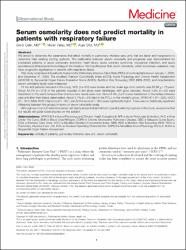| dc.contributor.author | Çelik, Deniz | |
| dc.contributor.author | Yıldız, Murat | |
| dc.contributor.author | Çifçi, Ayşe | |
| dc.date.accessioned | 2023-10-02T06:35:44Z | |
| dc.date.available | 2023-10-02T06:35:44Z | |
| dc.date.issued | 2022 | en_US |
| dc.identifier.uri | https://www.scopus.com/record/display.uri?eid=2-s2.0-85124501049&origin=resultslist&sort=plf-f&src=s&nlo=&nlr=&nls=&sid=20c4fe371b9b908d4f7e419f791331ff&sot=aff&sdt=cl&cluster=scofreetoread%2c%22all%22%2ct&sl=72&s=AF-ID%28%22Alanya+Alaaddin+Keykubat+University%22+60198720%29+AND+SUBJAREA%28MEDI%29&relpos=62&citeCnt=1&searchTerm= | |
| dc.identifier.uri | https://hdl.handle.net/20.500.12868/2372 | |
| dc.identifier.uri | https://journals.lww.com/md-journal/fulltext/2022/02110/serum_osmolarity_does_not_predict_mortality_in.46.aspx | |
| dc.description.abstract | AbstractWe aimed to determine the parameters that affect mortality in pulmonary intensive care units that are faster and inexpensive to determine than existing scoring systems. The relationship between serum osmolarity and prognosis was demonstrated for predialysis patients, in acute pulmonary embolism, heart failure, acute coronary syndrome, myocardial infarction, and acute spontaneous intracerebral hemorrhage in the literature. We hypothesized that serum osmolarity, which is routinely evaluated, may have prognostic significance in patients with respiratory failure.This study comprised 449 patients treated in the Pulmonary Intensive Care Clinic (PICU) of our hospital between January 1, 2020, and December 31, 2020. The modified Charlson Comorbidity Index (mCCI), Acute Physiology and Chronic Health Assessment (APACHE II), Sequential Organ Failure Evaluation Score (SOFA), Nutrition Risk Screening 2002 (NRS-2002), and hospitalization serum osmolarity levels were measured.Of the 449 patients included in the study, 65% (n = 292) were female and the mean age of all patients was 69.86 ± 1.72 years. About 83.1% (n = 373) of the patients included in the study were discharged with good recovery. About 4.9% (n = 22) were transferred to the ward because their intensive care needs were over. About 6.9% (n = 31) were transferred to the tertiary intensive care unit after their status deteriorated. About 5.1% (n = 23) died in the PICU. In the mortality group, APACHE II (P = .005), mCCI (P < .001), NRS-2002 total score (P < .001), and SOFA score (P < .001) were significantly higher. There was no statistically significant difference between the groups in terms of serum osmolarity levels.Although we could not determine serum osmolarity as a practical method to predict patient prognosis in this study, we assume that our results will guide future studies on this subject. | en_US |
| dc.language.iso | eng | en_US |
| dc.relation.isversionof | 10.1097/MD.0000000000028840 | en_US |
| dc.rights | info:eu-repo/semantics/openAccess | en_US |
| dc.subject | Critically ill patients | en_US |
| dc.subject | Pulmonary intensive care unit | en_US |
| dc.subject | Serum osmolarity | en_US |
| dc.title | Serum osmolarity does not predict mortality in patients with respiratory failure | en_US |
| dc.type | article | en_US |
| dc.contributor.department | ALKÜ, Fakülteler, Tıp Fakültesi, Dahili Tıp Bilimleri Bölümü | en_US |
| dc.identifier.volume | 101 | en_US |
| dc.identifier.issue | 6 | en_US |
| dc.relation.journal | Medicine (United States) | en_US |
| dc.relation.publicationcategory | Makale - Uluslararası Hakemli Dergi - Kurum Öğretim Elemanı | en_US |


















